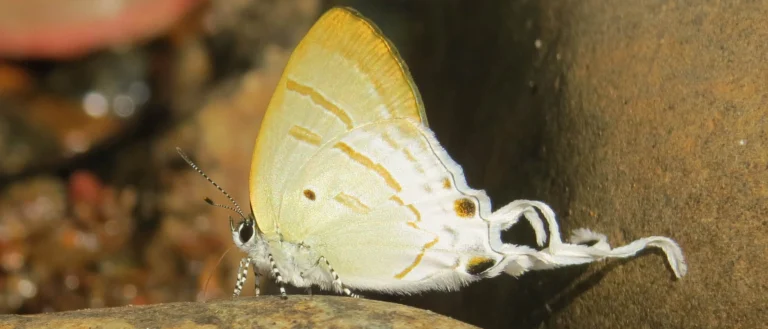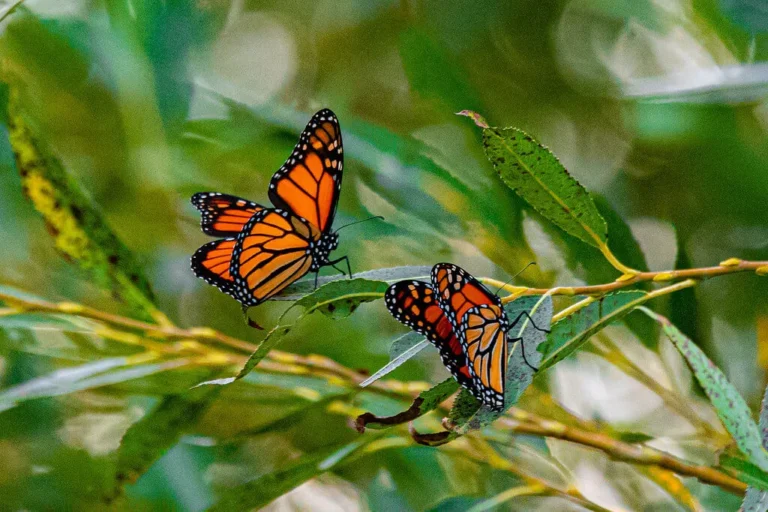Do Butterflies Bite? Decoding Myths, Anatomy & Behavior
Butterflies do not bite. They have a tube-like structure called a proboscis, used for sipping nectar from flowers. While butterflies can land on and interact with humans, the sensation felt is not a bite. Their primary diet is nectar, and their anatomy isn’t equipped for biting. Misconceptions arise from other insects’ behaviors or simple unfamiliarity with butterfly interactions.
Table of Contents
Introduction
Butterflies, with their vibrant colors and graceful flight patterns, have always been a subject of wonder and admiration. For many, these beautiful insects symbolize transformation and hope. But amidst this admiration, a question that often surfaces is about their behavior—specifically, do butterflies bite?
Understanding the behavior of insects, including butterflies, is more than just a matter of curiosity. It helps bridge the gap between humans and the intricate world of insects. We often hear stories of surprising insect interactions, and it’s natural for us to want to know more.
With butterflies, the question of whether they bite or not has been a topic of debate for some time. In this article, we’ll look into the anatomy and behavior of butterflies, debunking myths and highlighting facts.
Butterfly Anatomy 101
When observing a butterfly, one might primarily notice its stunning wings or perhaps its erratic flight pattern. However, the key to answering our main question lies in understanding a specific part of their anatomy: their mouthparts.
Butterflies, like many insects, have a unique feeding apparatus called a “proboscis.” Unlike the sharp biting mouthparts we see in insects like ants or beetles, a butterfly’s proboscis is more like a flexible straw. It’s coiled beneath their heads when not in use and extends when they feed on nectar.
This proboscis is specially designed to suck nectar from flowers. It’s not structured for biting or chewing like we might expect in other creatures. The very nature of this feeding tool hints that butterflies aren’t in the biting business.
However, this doesn’t mean all butterflies have the same anatomy. While the proboscis is a common feature, variations exist among different species. Some might have a longer or shorter proboscis, while others might have different patterns or colors on their wings.
Understanding these basics of butterfly anatomy gives us a clearer lens to view their behavior. With the foundation of this knowledge, we can now explore further and tackle the intriguing question head-on.
The Proboscis: A Closer Look
The proboscis, often mistaken as a potential biting tool, is truly one of the marvels of nature. It’s a perfect example of how evolution has tailored creatures to best fit their environment and needs.
At first glance, the proboscis might look like a simple, slender tube. However, it’s much more than that. This organ is formed by the fusion of two elongated structures, allowing it to be both flexible and strong.
When a butterfly isn’t feeding, it keeps the proboscis coiled close, like a watch spring, preserving it from potential damage.
What’s more fascinating is how butterflies use it. When they approach a flower, they uncoil the proboscis and expertly insert it into the flower, accessing nectar that’s often deep within. The proboscis acts like a super-efficient straw, helping the butterfly feed and providing the energy it needs to flutter about.
There’s also a common misconception that the proboscis might be used for biting, especially given its ability to extend and retract. However, this is not the case. The proboscis lacks any hard or sharp components that could potentially be used for biting.
Instead, its design is solely for the purpose of sipping nectar, a diet that’s crucial for the butterfly’s survival.
By understanding the intricate details of the proboscis and its function, it becomes clear that this tool is not meant for biting but for nourishment.
Comparing Butterflies with Other Insects
When it comes to insects, it’s easy to lump them all into one category, especially when thinking about biting or stinging behaviors. However, insects are a vastly diverse group, each equipped with its own unique set of tools tailored for survival.
For example, ants with their strong mandibles are adept at biting. Meanwhile, butterflies, with their flexible butterfly antenna, are more adapted to sensing their environment and finding food sources.
Mosquitos are another great example. These tiny creatures have piercing mouthparts, enabling them to feed on the blood of hosts. Their proboscis is sharp and needle-like, quite different from the flexible tube of a butterfly. Then we have ants, particularly the ones that bite.
They possess strong mandibles used for gripping, carrying, and yes, biting when they feel threatened.
Compared to these insects, butterflies seem gentle, don’t they? The proboscis of a butterfly is not designed for defense or aggression. Its main purpose is to extract nectar from flowers, providing the necessary nutrition for the butterfly to survive and reproduce.
It’s essential to remember that each insect has evolved over millions of years to fit its niche perfectly. While some insects have developed biting or stinging mechanisms for defense or feeding, butterflies have taken a different path.
Their survival doesn’t rely on biting but on their ability to sip nectar and evade predators, often using their colorful wings as camouflage or warning signs.
Understanding these differences puts into perspective the uniqueness of each insect and how they’ve adapted to their environment. It’s a testament to the varied and fascinating world of insects that share our planet.
Do Butterflies Bite Humans?
The quick answer to this burning question is: No, butterflies do not bite humans. But let’s explore why this query even arises and clarify some misconceptions.
Firstly, the sensation of a butterfly landing on a person can be surprising. Their legs might feel prickly, and if one isn’t accustomed to it, they might mistake that sensation for a bite. But in reality, the butterfly is merely holding onto the skin or clothing, ensuring it doesn’t fall off.
Moreover, some enthusiasts, when handling butterflies, might feel a slight pinch. This isn’t a bite but rather the butterfly’s attempt to grip onto something. Remember, their primary tools for interaction with their environment are their legs and proboscis, neither of which are designed for biting.
Another factor that contributes to this misconception is the behavior of other closely related insects. For example, moths, which are close relatives of butterflies, don’t bite either, but some species might have more noticeable and bristly legs. When they land on skin, the sensation could feel more pronounced, leading some to believe they’ve been bitten.
In essence, while butterflies can interact with humans in various ways, biting isn’t one of them. Their anatomy and behavior are geared towards feeding on nectar and reproducing, not engaging in aggressive actions toward humans.
Butterfly Behavior with Other Animals
Butterflies, as serene and gentle as they appear, aren’t just passive inhabitants of our world. They have their roles, interactions, and mechanisms of defense when it comes to dealing with other animals.
Predators, such as birds or even other larger insects, often find butterflies an attractive meal. However, butterflies have evolved various tactics to protect themselves. Contrary to what one might think, biting is not one of them.
One of the primary defense mechanisms butterflies employ is their appearance. Some species have developed eye-like patterns on their wings, which can startle or deter potential predators. These eyespots can give the illusion of a larger, more threatening creature, causing a predator to think twice before making a move.
Other butterflies employ the strategy of mimicry. Some harmless species have evolved to look like other toxic or foul-tasting species. When a predator encounters them and remembers a previous unpleasant experience with a genuinely toxic butterfly, they are likely to avoid the mimic as well.
There are also those butterflies that, when threatened, release a foul-smelling substance. This odor can deter predators from seeing them as a potential meal.
Lastly, the simple act of erratic flying, which butterflies are well known for, can be a defense mechanism in itself. Their unpredictable flight patterns can make it challenging for predators to catch them in mid-air.
While these interactions and behaviors are intriguing, it’s clear that biting is not in the butterfly’s repertoire of responses. They rely on evasion, appearance, and sometimes chemistry to ensure their survival, rather than direct confrontation.
Why the Confusion?
It’s not uncommon for myths and misconceptions to cloud our understanding of the natural world. When it comes to butterflies, the idea that they might bite has its roots in a mix of experiences and stories.
- Physical Interaction: As mentioned before, the sensation of a butterfly landing can be unfamiliar to many. The touch of their tiny legs can be mistaken for a nibble, especially if one is already apprehensive or unfamiliar with insects.
- Similar Insect Behaviors: Other insects might bite or sting, leading to a general apprehension towards all insects, butterflies included. For example, a person might get bitten by a beetle or a mosquito and later see a butterfly nearby, wrongly attributing the bite to it.
- Misidentifications: Not all winged insects are butterflies. Some insects, which might have a superficial resemblance to butterflies, could have biting behaviors. An interaction with such an insect could lead to mistaken identity, with the butterfly getting the blame.
- Tales and Stories: Sometimes, stories or urban legends can perpetuate myths. An anecdotal tale of a butterfly “bite” can be passed on and, over time, taken as fact by those who hear it.
Conclusion
Butterflies, with their mesmerizing colors and ethereal beauty, have long captured our imaginations. Their gentle nature, combined with their intricate designs, makes them one of nature’s most admired creatures. However, like many beings in the animal kingdom, misconceptions can cloud our understanding of them.
In our exploration of the question, “Do butterflies bite?”, we’ve delved deep into their anatomy, behaviors, and the origins of some common myths. The verdict is clear: butterflies do not bite. Their world revolves around sipping nectar, avoiding predators, and ensuring the survival of their species.
Understanding the true nature of these insects allows us to better appreciate their role in our ecosystem and to coexist peacefully.
So, the next time you see a butterfly fluttering around, remember the wonders of its proboscis, its non-biting behavior, and the intricate dance of survival it performs daily. Celebrate the beauty of nature and the endless mysteries it offers us.



